Lenny was diagnosed with high-cholesterol and he didn’t want to go on medication, nor did he want to give up eating the foods he loved. One of them was nuts. I started researching ways of incorporating good nuts such of walnuts into our diet. His doctor told us that if we added 4 – 5 servings of nuts that are rich in polyunsaturated fatty acids per week, it would help keep blood vessels healthy and elastic. Pretty simple addition to helping make a healthy difference in one’s diet. Don’t you agree? This recipe for a Sage and Walnut Pesto is the first of many that we will be developing using nuts as a heart healthy add-in.
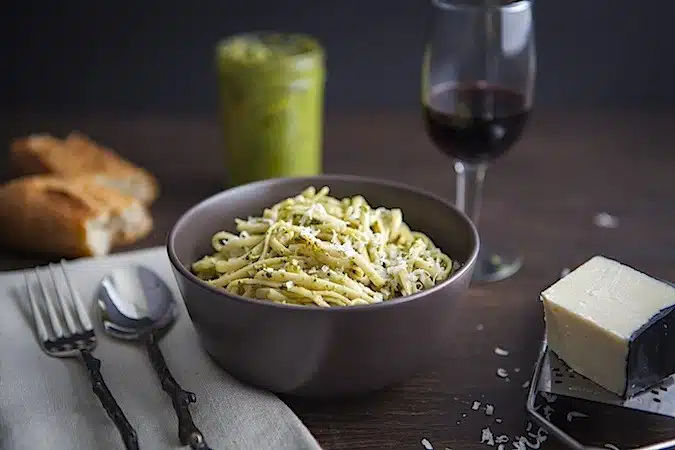
When the California Walnut association invited me to tour a walnut farm during harvest, I jumped at the chance. I had always wanted to see a walnut tree shaken (I know, one of those weird food fantasies), and now I had the chance to participate in a harvest, as well as learn more about walnuts. Let me start by saying, walnuts are often overlooked in our home as they have the reputation of being high in calories.
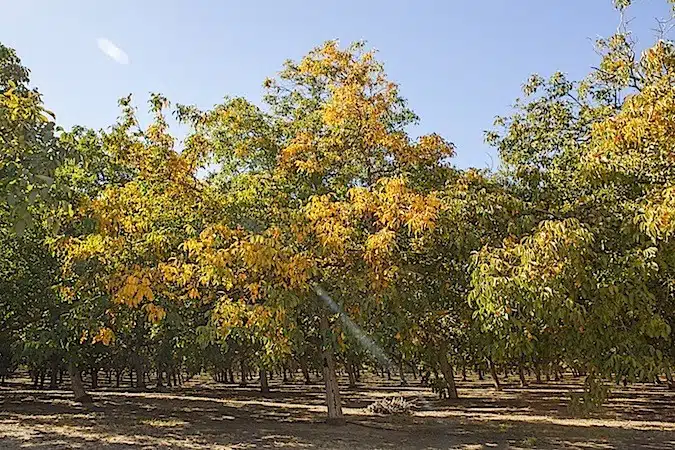
The day started out with an informal chat about walnuts as we made our way to the Mariani Nut Company in Winters, California. I am sure most of us don’t put a lot of thought into where our food comes from or how it came to us. This is important to us, so I was all ears. The California walnut industry is made up of more than 4,000 walnut growers, and they account for more than 90% of the U.S. supply. I found it interesting that the walnut industry in California also controls about three-fourths of the world trade of walnuts.
Walnuts made their way to California in the early 1700s by way of Franciscan Fathers from Spain. History has it that walnuts made their way originally from Persia where they were enjoyed by royalty. Growing conditions in California are ideal as the ground is fertile, deep and well-drained. As well the dry summer weather in the North Eastern area of the Bay Area helps the walnuts flourish. Walnut trees are solid and can grow upward of 100 feet, creating a gorgeous canopy over the fields. Their leaves are aromatic, and the fruit is a vibrant, fuzzy green skin, that protects the walnut shell. It does take a walnut tree 5 – 7 years to produce and it will continue to do so up to a century.
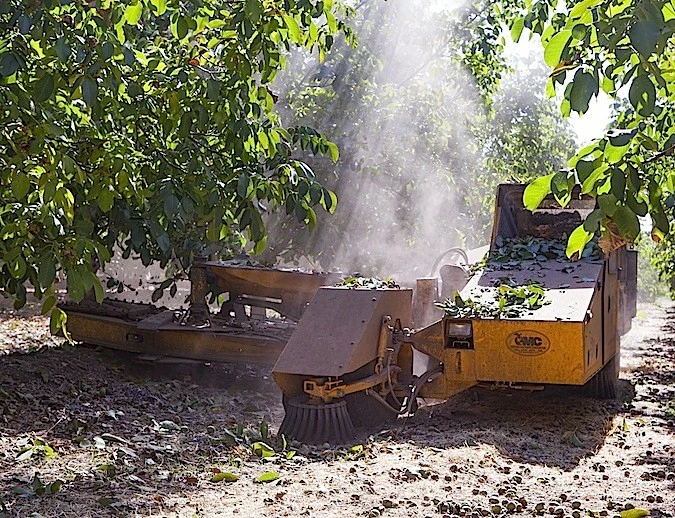
Harvest season is from September – November, during our Indian summer, when conditions are dry and hot. The nuts are harvested from the trees by mechanical shakers, which shake the nuts to the ground with such a forceful rumble that the earth actually moves. It was pretty amazing, and I am sorry that I did not video the entire process; you would have loved it. The nuts are then swept from the orchard floor by mechanical harvesters, where they are taken to the processing facilities. There they are cleaned, packaged and shipped out to consumers.
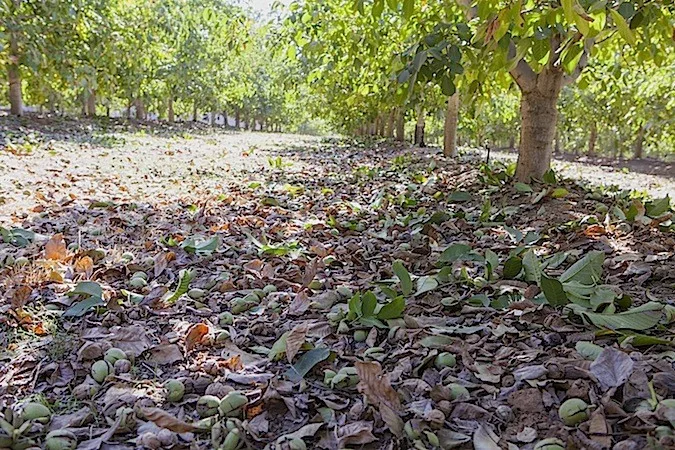
California walnuts have been certified with the American Heart Associate as a heart-healthy food. I was overjoyed to hear this. Eating a handful of walnuts a day is a great way to help protect your heart as they offer antioxidants, vitamins, fiber, protein and the plant-based omega-3 fatty acid alpha-linolenic acid. Did you know that by adding nuts, fish and other food that are rich sources of good fats, monounsaturated and polyunsaturated fats, gives you more healthy options for your diet? Just one ounce of walnuts provides 18g of total fat, 2.5g of monounsaturated fat, 13g of polyunsaturated fat, including 2.5g of alpha linolenic acid – the plant-based omega-3; 2g of fiber, 4g of protein, 3.68 mmil/28g of antioxidants (per the American Heart Association).

After experiencing the walnut harvest and enjoying a lovely lunch in a walnut field, we went to the processing plant to see how the nuts were packaged. In a nutshell, the walnuts are brought into the facility, where they are cracked, sorted, cleaned and packaged. They are sent out in consumer-sized bags or bulk, as well they are sold in halves, pieces, chopped or even as a flour. The walnuts are stored in a cool, dry storage unit until it is time to ship them to retail stores or overseas. Their shelve life is 6 months unless you store them in sealed containers in the freezer or refrigerator, then they will last up to a year.

As I mentioned before, I have been slowly incorporating different nuts into our diets. Prior to visiting the walnut farm, I had been adding walnuts to savory recipes that I am developing. Little did I know, before the day spent in the orchard, about how healthy walnuts actually are.
One of my favorite ways to use walnuts in savory recipes is to add them to pesto or spreads. I omit the dairy and add an abundance of nuts. The texture is thicker, making it great as a spread for crackers too.
I developed this particular recipe to pair with a pork tenderloin. Unfortunately, we have not had a chance to try it with the pork as we have been enjoying it with pasta, as well as spread over baguettes in place of butter or cheese. It is made loaded with spinach, fresh sage and toasted walnuts. Sage is a great herb to enjoy in the Fall and Winter months, as it really warms up a dish, not to mention it is so aromatic when cooking with it.
I would like to thank the California Walnut Board, The Mariani Nut Company, Ramos Farms and Torme Lauricella Public Relations for inviting Chez Us to spend the day learning about California Walnuts. To see rest of the photo essay from the day, head over to our online photo album. Enjoy!
Disclosure: This was an unpaid write-up and was sponsored by the California Walnut Board. All opinions expressed are my own.
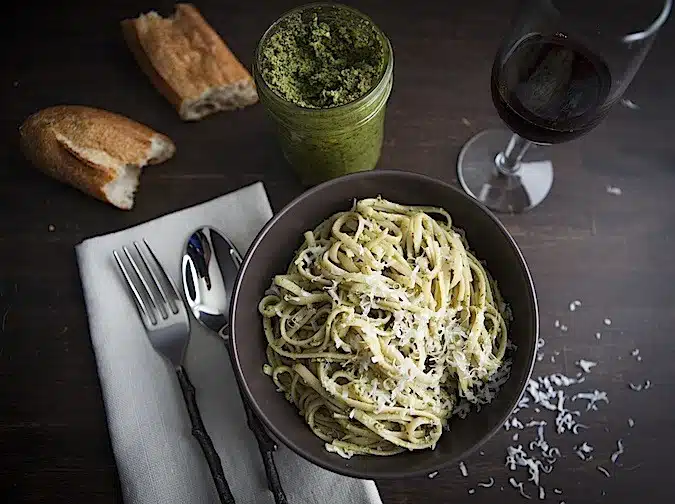
Sage and Walnut Pesto

Sage and walnuts make this fall forward tasty pesto sauce that is great on pasta or with grilled chicken.
Ingredients
- 1 1/2 cup toasted walnuts
- 2 cups of fresh spinach
- 1/2 small shallot
- 2 cloves fresh garlic
- 1 cup loosely packed fresh sage leaves
- 3/4 cup olive oil
- kosher salt to taste
- fresh cracked black pepper
Instructions
Place all ingredients except the olive oil in a food processor.
Pulse until finely chopped, almost a paste consistency.
With the food processor running, slowly drizzle in the olive oil.
Continue pulsing until well mixed.
Season with the salt and pepper.
Serve.
Eat.


El
Thursday 1st of November 2012
This is so cool. I've never seen a walnut harvest. I love the idea of walnut pesto. Sounds fantastic.
ilva
Tuesday 30th of October 2012
How nice, I was invited to that tour too (yes it seems to me they sort of forgot to check out where I actually live...) and I wanted to go but it would have been a bit too expensive. So reading about it here is a delight, very interesting and fine photos too!
Dana
Monday 29th of October 2012
Nuts are truly one of those foods that I forget about. They are so good for you on so many levels and I almost never eat them. What a cool opportunity for you to go on that visit! The pasta, by the way, looks amazing.
Vijitha
Monday 29th of October 2012
I have been making a lot of pesto with sage and basil these days. I love it because they are the easiest dinner on weekdays. I always use walnuts as pine nuts are little heavy on the pocket.
jaime @ sweet road
Monday 29th of October 2012
I love the creativity I always see put into new pesto recipes. Sage and walnut sounds wonderful!